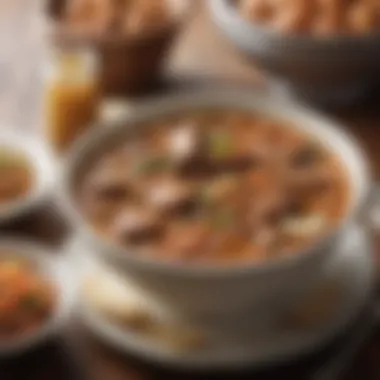Discover Lafayette's Culinary Treasures: Best Eats Guide


Intro
Lafayette, Louisiana, stands as a beacon of culinary excellence within a rich cultural tapestry. Nestled in the heart of Acadiana, Lafayette is renowned not just for its picturesque landscapes but also for the remarkable diversity of its food offerings. This exploration aims to serve culinary enthusiasts and intrepid foodies alike by dissecting the traditional Cajun and Creole dishes that dominate the landscape, while also uncovering local favorites and innovative culinary trends.
Understanding the culinary landscape of Lafayette requires a closer examination of its influences which come from its historical mingling of cultures. The blend of French, Spanish, African, and Native American heritages forms a unique gastronomic experience that showcases distinct flavors and cooking techniques. Here, dining is not merely a routine; it is a cultural event that embodies community spirit and pride.
In the forthcoming sections, we will delve into various aspects of Lafayette’s culinary scene, from the vibrant local dining establishments to emerging food trends that forecast where the food culture is headed. Prepare for an in-depth examination that highlights the indelible mark Lafayette leaves on the plates of those fortunate enough to experience its cuisine.
Understanding Lafayette's Culinary Identity
Lafayette's culinary identity is a reflection of its rich past and diverse cultural influences. Understanding this identity is crucial for grasping the essence of the region's food scene. The interplay of local traditions, historical events, and the melting pot of cultures has created a unique gastronomic landscape. This understanding allows food enthusiasts to appreciate not just the flavors, but also the stories and traditions behind each dish.
The food culture here is not merely about sustenance; it represents a community's heritage. Recognizing the significance of local ingredients, cooking methods, and traditional recipes enhances the overall dining experience. As one seeks out culinary options in Lafayette, understanding its identity will enrich the journey of discovery and exploration.
Historical Context of Lafayette's Cuisine
The historical context of Lafayette's cuisine is deeply intertwined with the region's settlement patterns. The area has been shaped by various waves of immigrants, primarily French, Spanish, and African. This blend of influences is responsible for the distinctive Cajun and Creole food traditions we see today.
In the 18th century, French settlers brought with them culinary practices that emphasized the use of local ingredients. The introduction of spices and cooking techniques from African and Spanish cultures added complexity and depth to the local food. Understanding this historical context helps to appreciate why certain dishes, such as gumbo and jambalaya, have become staples in Lafayette.
Overall, the history of Lafayette's cuisine illustrates an ongoing evolution, where each community has left its mark on the culinary landscape. This past informs present day preferences and dining options, making it a vital area of exploration for anyone interested in Lafayette's food scene.
Cultural Influences on Local Food
Lafayette's culinary scene is a testament to several cultural influences that have molded the local food practices. The Creole and Cajun cultures dominate the landscape, but they are far from the only contributors. The blending of these cultures with influences from Native American food traditions and immigrant communities has resulted in a diverse exposure to flavors and techniques.
Local food is marked by the vibrant use of spices, fresh seafood, and farm-to-table ingredients. Cultural events and community gatherings often revolve around food, highlighting its role in social bonding. Additionally, popular cooking styles such as frying, smoking, and slow-cooking can be seen throughout local dishes, each rooted in the rich tapestry of traditions that define Lafayette's culinary identity.
Understanding these influences is essential for anyone wishing to delve into Lafayette's cuisine. It provides a broader context for why certain flavors hold prominence and helps to navigate through the extensive variety of locally available dishes. Additionally, recognizing the impact of culture on food can guide diners toward making informed choices that resonate with the region's unique culinary story.
Signature Dishes of Lafayette
The culinary scene of Lafayette is distinguished by its signature dishes, each contributing a unique flair to the local gastronomy. These dishes are not merely meals but narratives reflecting the history and cultural evolution of this vibrant city. They combine traditional techniques and local ingredients, showcasing the creativity that defines Lafayette's food landscape. Understanding these signature dishes offers insights into the local identity and builds a connection between the community and its culinary traditions. Each dish illuminates the ways in which Lafayette's diverse cultural heritage continues to influence and enrich its food culture.
Gumbo: A Staple of Cajun Cooking
Gumbo is more than just a dish; it is a cultural emblem of Lafayette and wider Louisiana. This hearty stew combines various ingredients, typically including mudbugs such as shrimp, sausage, and okra, thickened with a dark roux. The preparation of gumbo varies significantly between chefs, and the diversity in ingredients often reflects personal and family traditions. Thus, every bowl has a story to tell.
Notably, gumbo is cherished for its adaptability. It can be made with shellfish, poultry, and even vegan options, making it a versatile feast suitable for different dietary preferences. It symbolizes warmth and hospitality; it is common for families to gather and share this dish during celebrations.
In essence, gumbo represents the heart of Cajun cooking. Its flavors connect the past to the present, serving as a reminder of French, African, Spanish, and Native American influences that shaped Lafayette’s culinary identity.
Etouffee: A Dish with Depth and Character
Etouffee is another cornerstone of Lafayette's cuisine. Primarily made with shellfish or chicken, this dish is cooked in a rich sauce typically seasoned with the Holy Trinity of Cajun cooking: bell peppers, onions, and celery. The name “etouffee” refers to the method of cooking, which involves smothering the main protein in a flavorful sauce.
This dish can vary from restaurant to restaurant, reflecting local ingredients and individual chef's interpretations. Some may prefer it spicy, while others might highlight the sweetness of tomatoes and vegetables in the sauce. Etouffee is often served over rice, which absorbs the flavorful juices, enhancing each bite.
As a testament to its bold flavors and character, etouffee showcases the depth of Lafayette’s culinary techniques, allowing every spoonful to provide a satisfying experience. It is a celebration of the region's rich seafood heritage.


Jambalaya: A Flavorful One-Pot Meal
Jambalaya is a quintessential one-pot meal that embodies the culinary spirit of Lafayette. This dish combines rice with various proteins, usually chicken, sausage, and seafood, alongside vegetables and a mix of spices. The vibrant combination of flavors and textures makes it an exciting dish to share among family and friends.
Similar to gumbo, jambalaya has roots in the different cultures that coalesce in Lafayette, including Spanish, French, and Louisiana Creole influences. It's commonly prepared in large quantities, making it an ideal dish for gatherings, festivities, or large family dinners.
Variants of jambalaya also exist, notably the Creole style that includes tomatoes and the Cajun style that does not. Each presents a different taste while still being warmly embraced by locals. The adaptable nature of jambalaya allows chefs to personalize recipes, assuring that this dish will never become stagnant; instead, it epitomizes the continual evolution of Lafayette's culinary traditions.
In summary, the signature dishes of Lafayette—gumbo, etouffee, and jambalaya—serve as more than just food; they embody a rich cultural tapestry woven from history, tradition, and community engagement. Understanding these offerings is crucial for anyone seeking to appreciate the culinary landscape of this unique city.
Top Restaurants in Lafayette
Exploring the vibrant culinary scene of Lafayette naturally leads to a close examination of its top restaurants. These establishments are not merely places to eat; they are cultural hubs that reflect the city's identity, offering insight into the unique flavors of Cajun and Creole cuisine. The best restaurants serve as homes for local ingredients and showcase the creativity of Lafayette’s chefs. This section emphasizes the role of these dining spots in the culinary landscape, highlighting their contributions to culinary innovation and community engagement.
Local Favorites: A Review of Must-Visit Spots
Lafayette’s local favorites are where tradition meets warmth. These restaurants prioritize local flavors, often featuring recipes passed down through generations. A standout is Prejean's Restaurant, celebrated for its authentic Cajun dishes and lively atmosphere. Another local treasure is The Pink Elephant, a casual eatery known for its welcoming ambiance and delicious crawfish étouffée. These places form a crucial part of Lafayette's dining experience, attracting both locals and visitors alike.
- Prejean's Restaurant: A family-owned restaurant famous for its lively music and traditional Cajun dishes.
- The Pink Elephant: Known for its laid-back vibe and exceptional seafood.
Alongside these established names, smaller eateries like Bon Temps Grill offer a unique take on local fare, featuring a diverse menu that caters to various tastes.
Local favorites are essential for those looking to experience the heart of Lafayette’s culinary scene.
Fine Dining: Elevating the Culinary Experience
Lafayette's fine dining establishments present a more refined experience, one that often integrates local ingredients with international culinary techniques. Giorgio's Cajun & Italian Restaurant exemplifies this with its thoughtful blend of Cajun and Italian flavors. The ambiance here is elegantly designed, providing diners with a sophisticated setting for their meals.
- Giorgio's offers a unique intersection of cultures, featuring dishes like blackened fish with a side of handmade pasta.
Ruth's Chris Steak House stands out for its high-quality steaks and excellent service. This restaurant elevates traditional meals through meticulous preparation and a focus on ingredient quality. The fine dining scene in Lafayette allows guests to appreciate luxurious meals while still celebrating the area’s unique culinary heritage.
Hidden Gems: Underrated Culinary Establishments
Not all culinary treasures in Lafayette are well-known. Some are hidden gems that provide deep insights into local food culture. The French Press is one such place, renowned for its artisanal breakfast and brunch offerings. From fluffy pancakes to robust coffee, this café captures the essence of a cozy dining experience.
Another underrated establishment is Shadows on the Teche. While primarily known as a historic site, their restaurant serves delightful home-cooked meals with a Creole twist, often using ingredients sourced from local farmers.
- The French Press: Offers a relaxed atmosphere with a strong focus on breakfast.
- Shadows on the Teche: Combines history with delicious local fare.
These hidden gems contribute significantly to Lafayette's culinary identity, often reflecting strong community ties and a commitment to quality.
"True culinary exploration in Lafayette is not just about the known, but also the undiscovered."
The landscape of Lafayette’s top restaurants is diverse and engaging. Each dining experience reflects different facets of local culture, showcasing the rich tapestry of flavors that define this area. Visitors to Lafayette should engage with both popular establishments and hidden gems to gain a holistic view of this city’s culinary identity.
Street Food and Markets in Lafayette
Street food and markets represent a vibrant cornerstone of Lafayette's culinary heritage. These settings not only showcase local flavors but also reflect the community's culture and traditions. In Lafayette, food trucks and farmers' markets have gained popularity, offering experiences that are both unique and deeply rooted in local produce and gastronomy. The following sections provide a detailed look at these important elements of Lafayette's food scene.
Food Trucks: A Growing Trend


Food trucks in Lafayette have become a cultural phenomenon, illustrating the city's dynamic food landscape. These mobile kitchens serve diverse offerings from traditional Cajun dishes to innovative fusion cuisine.
Some well-known food trucks include:
- Cajun King: Specializes in gumbo and po'boys.
- Bodacious Boudin: Focuses on boudin balls and other pork specialties.
- Melt Mobile: Offers gourmet grilled cheese sandwiches with local cheeses.
These food trucks not only provide delicious meals but also emphasize accessibility and convenience. Residents and visitors alike can explore Lafayette's culinary diversity without needing to sit down at a restaurant. Additionally, food truck festivals and community events have helped create a sense of belonging among food enthusiasts, fostering connections through the love of food.
It's also worth noting how food trucks adapt to seasonal ingredients and local trends. They often rotate menus to feature fresh produce sourced from local farms. This enhances the overall experience, making street food an essential aspect of Lafayette's culinary identity.
Farmers' Markets: Celebrating Local Produce
Farmers' markets in Lafayette play a significant role in promoting local agriculture and sustainable eating. They are gathering places where farmers sell fresh fruits, vegetables, meat, and artisanal products directly to consumers. The markets are typically held on weekends and attract a variety of vendors and shoppers.
Regular features of Lafayette farmers' markets include:
- Fresh Produce: Seasonal fruits and vegetables from local farms.
- Artisan Foods: Homemade jams, breads, and cheeses.
- Crafts and Goods: Handmade crafts, including pottery and textiles.
This direct-to-consumer model ensures that the community supports local farmers, fostering relationships between producers and consumers. This accessibility to fresh, local ingredients also inspires chefs and home cooks alike, leading to innovative dishes that highlight the quality of local products.
"Farmers' markets not only promote healthy eating but also strengthen our community bonds by connecting people with their food sources."
Vegan and Vegetarian Options in Lafayette
In recent years, the culinary landscape of Lafayette has expanded to embrace vegan and vegetarian options more robustly. This shift reflects a broader trend throughout the United States as many individuals adopt plant-based diets for health, ethical, and environmental reasons. Understanding these options is essential for food lovers seeking to explore Lafayette's dynamic food scene while aligning with healthier lifestyle choices.
Emerging Plant-Based Trends
The interest in plant-based diets has led to several emerging trends in Lafayette. Restaurants are increasingly focusing on local, organic ingredients. Some establishments source vegetables directly from nearby farms. This commitment not only supports local agriculture but also enhances the freshness of the dishes. Additionally, there is a rise in the creativity and variety of plant-based dishes offered.
Another trend is the integration of traditional Cajun flavors into vegan meals. For instance, dishes that utilize smoked spices, traditional sauces, and rich flavors are being reinvented to cater to vegetarians and vegans. Local chefs are experimenting with ingredients such as jackfruit to mimic the textures of meat, and lentils and chickpeas are becoming staples in many menus. These innovations help broaden the appeal of plant-based eating, attracting a wider audience than ever before.
"The culinary scene of Lafayette is adapting, making way for a diverse array of plant-based options that respect its root flavors."
Top Restaurants with Vegetarian Menus
Several restaurants in Lafayette have made significant strides in catering to vegetarian and vegan diets. Here are some notable establishments:
- The French Press
This café is well-known for its commitment to quality coffee and fresh meals. Their vegetarian items include pistolet sandwiches and a variety of salads featuring fresh, local ingredients. - The Railhouse
A place where the culinary arts shine through innovative dishes. Their vegetarian offerings are flavorful and redefine classic Cajun cuisine, incorporating local vegetables and spices into every plate. - The Greenhouse
Dedicated entirely to plant-based cuisine, this restaurant features an extensive menu where every dish honors the essence of local flavors. Their focus on organic sourcing ensures meals that are both healthy and delicious. - Zorba's Greek Taco
While this may seem like a casual eatery, Zorba's provides a wonderful collection of vegetarian tacos. Their unique flavors capture the essence of Mediterranean and Cajun influences, making it a must-visit for vegans and vegetarians alike.
The growing prevalence of these offerings marks a significant change in the culinary narrative of Lafayette. This progress is essential not only for providing diverse options to a variety of diets but also for fostering a more inclusive food culture.
As Lafayette continues to grow, so too will its dedication to ensuring that every diner feels represented in its culinary offerings.
Culinary Events and Festivals
Culinary events and festivals play a crucial role in showcasing Lafayette's vibrant food culture. They serve not only as a celebration of local cuisine but also as a platform for chefs, farmers, and food artisans to come together, share their skills, and promote regional flavors. These events allow both residents and visitors to experience the depth of Lafayette's culinary identity while fostering a sense of community and cultural pride. Through tastings, workshops, and performances, these gatherings enhance the gastronomic landscape, creating opportunities for social connections and culinary exploration.
Annual Taste of Lafayette Festival


The Annual Taste of Lafayette Festival stands as a hallmark event in the local culinary calendar. Each year, this festival attracts food enthusiasts eager to savor the distinctive tastes that Lafayette has to offer. Local restaurants, chefs, and food vendors unite to present their signature dishes, giving participants a chance to sample a variety of flavors all in one place.
Attendees can expect to enjoy
- Gumbo
- Etouffee
- Jambalaya
- Boudin
- Sweet treats like beignets
This festival not only promotes traditional Cajun and Creole dishes but also embraces new culinary trends, showcasing innovations that local chefs experiment with. The dynamic atmosphere is enhanced by live music and entertainment, providing a fun backdrop for culinary exploration.
Cultural Celebrations and Their Culinary Significance
Cultural celebrations in Lafayette often intertwine with its culinary practices, revealing the heritage and stories behind local dishes. Events like Mardi Gras and Acadian Heritage Day present an opportunity to delve deeper into the historical context of food. Here, traditional recipes are not just served; they are shared, reflecting the cultural narratives of the diverse communities within Lafayette.
Such celebrations emphasize the significance of food as a medium of cultural expression. They highlight how families pass down recipes through generations, each dish becoming a storyteller of its own. These events foster community engagement, bringing people together around a shared appreciation for food and culture.
"Food is central to our celebrations; it blooms the heart and nourishes connections among us."
In essence, culinary events and festivals in Lafayette celebrate not only food but also the stories that accompany them. This blend of tradition and innovation captures the essence of what makes Lafayette's culinary landscape both rich and inviting.
Food Pairing and Pairing Wine with Local Dishes
Food pairing is an essential element in enhancing the dining experience. In Lafayette, Louisiana, this is particularly vital due to the unique flavors found in local dishes. An understanding of food pairing can elevate the culinary experience, bringing out the intricate flavors of each component. Proper combinations can make a meal memorable, highlighting both the food and drink. For those who appreciate the complexity of tastes, having the right wine with local dishes is key. It adds depth and dimension, making each dining event more enjoyable.
Traditional Pairings and Innovations
In Lafayette, traditional food pairings often reflect regional heritage. Cajun and Creole cuisine brings robust flavors, and pairing wines with these dishes requires careful thought. For example, a classic gumbo pairs well with a full-bodied white wine like Chardonnay. This wine complements the spices and richness of the dish.
On the other hand, innovations in food pairing are becoming popular among local chefs. They experiment with unconventional combinations, such as pairing spicy jambalaya with fruity Riesling. This opening of possibilities broadens the culinary landscape. New pairings do not only aim to complement, but also to contrast flavors, creating a delightful experience.
Expert Recommendations for Food-Wine Pairings
Local experts have shared insights regarding ideal wine pairings for Lafayette dishes. These recommendations help both locals and visitors alike create successful culinary matches.
- Gumbo: Pair this hearty dish with a dry Riesling or a Zinfandel. The acidity in wine cuts through the dish's richness.
- Etouffee: Opt for an off-dry white like Pinot Gris. It balances the spice and buttery elements of the sauce.
- Jambalaya: A medium-bodied red wine such as Merlot complements the robust flavors, making it an enjoyable pairing.
For lighter dishes, like grilled seafood, consider a Sauvignon Blanc. It enhances the delicate flavors without overpowering them.
When exploring food and wine pairings, it is crucial to consider not just the primary flavors but also textures and aromas. Each pairing can transform a meal and create a noteworthy dining experience.
By being informed about local cuisine and suggested pairings, individuals can enhance their culinary adventure in Lafayette. This understanding encourages a deeper appreciation for the local food scene.
Epilogue: The Future of Lafayette's Culinary Scene
The culinary scene in Lafayette, Louisiana is at a crucial juncture. As the city balances its rich culinary heritage with contemporary gastronomic trends, the future will hinge on how well it preserves tradition while adapting to changing tastes. Culinary enthusiasts must recognize this duality as pivotal for sustaining Lafayette's unique food culture.
Preserving Tradition While Embracing Change
The Cajun and Creole traditions are the backbone of Lafayette's culinary identity. Restaurants like Prejean's and La Fonda emphasize these traditional methods, ensuring that locals and visitors experience authentic flavors. However, alongside these staples, newer establishments are experimenting with ingredients and techniques that reflect broader culinary trends. This combination enriches the local palate. For example, The Trading Post introduces local ingredients into modern dishes, creatively marrying tradition with innovation.
Preserving traditions serves to honor the area’s history and educate future generations. At the same time, adapting to modern influences can attract new visitors and residents who appreciate diverse culinary experiences. The challenge ahead lies in finding a balance where both elements coexist harmoniously, maintaining authentic flavors while also being receptive to the global food landscape.
Engaging the Community in Culinary Exploration
Engagement is vital in forming a vibrant food community. Lafayette's culinary future depends on the active participation of its residents. Initiatives such as Lafayette Food Tours and local cooking classes create opportunities for people to learn about their food heritage. This fosters appreciation for local ingredients and boosts the economy by supporting local farmers and producers.
Furthermore, community events and festivals, like the Annual Taste of Lafayette Festival, help unite residents, chefs, and food lovers. These events highlight local talent and encourage innovation. By actively involving community members in these culinary explorations, Lafayette can cultivate a more inclusive food culture. Collaborations between local chefs and farmers can lead to unique dining experiences that appeal to a wider audience.
"As we move forward, it's essential for Lafayette to cultivate its unique culinary landscape, balancing tradition with innovation while engaging the community in every step of the culinary journey."















